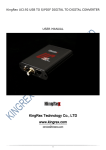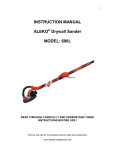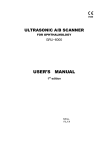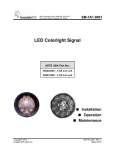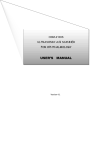Download Dwyer 641B Air Velocity Transmitter Manual PDF
Transcript
641B bulletin 2/8/05 11:04 AM Page 1 Bulletin E-66-B Series 641B Air Velocity Transmitter Specifications - Installation and Operating Instructions 9-1/4 [235.0] 1/2 NPT 4-31/32 [126.21] 1-23/32 [43.66] The Series 641B Air Velocity Transmitter uses a heated mass flow sensor technology. It has 4 user selectable ranges from 250 FPM to 2000 FPM with corresponding metric ranges of 1.25 MPS to 10 MPS. The 641B provides an isolated 4-20 mA output proportional to the velocity. SPECIFICATIONS Mounting: The 641B should be connected to conduit or other connection means with the 1/2˝ NPT conduit connection. Ensure connection is installed properly so that dust and debris can not enter housing. Service: Air and compatible, non-combustible gases. Accuracy: 5% FS Process gas: 32 to 122° F (0 to 50°C). 6% FS Process gas: -40 to 32°F & 122 to 176°F (-40 to 0°C & 50 to 80°C). Response Time: Flow: 1.5 seconds to 95% of final value (Output filter set to minimum). Temperature Limits: Process: -40 to 176°F (-40 to 80°C). Ambient: 32 to 140°F (0 to 60°C). Humidity Limit: Non-Condensing. Power Requirements: 12–35 VDC, 10–16 VAC. Output Signal: 4-20 mA, isolated 24V source, 3 or 4-wire connection. Output Filter: Selectable 0.5 –15 (seconds). Loop Resistance: 600 ohms max. Current Consumption: 300 mA max*. Electrical Connections: Screw terminal. Enclosure Rating: Designed to meet NEMA 4X. Mounting Orientation: Unit not position sensitive. Weight: 12.6 oz (357.2 g). Airflow: The 641B is intended for use with dry air. Dust accumulation on sensor may impair the velocity measurement and will require probe cleaning. * A brief current transient exceeding 300 mA may be seen on startup. INSTALLATION Location: Select a location where the temperature will be within 32 to 140°F (0 to 60°C). The transmitter may be located any distance from the receiver provided that the total loop resistance does not exceed 600 ohms. The probe should be located where conditions are representative of the overall environment being monitored. Avoid locations where turbulence, stagnation, or rapidly fluctuating velocities or temperatures are present as these conditions may affect the readings. The filter setting may be used to average velocity readings in turbulent conditions. Position: The transmitter is not position sensitive and may be mounted in any orientation. See maintenance section for additional cleaning details. DWYER INSTRUMENTS, INC. P.O. BOX 373 • MICHIGAN CITY, INDIANA 46361, U.S.A. Phone: 219/879-8000 Fax: 219/872-9057 www.dwyer-inst.com e-mail: [email protected] 641B bulletin 2/8/05 11:04 AM Page 2 Page 2 NOTE: Where conduit connections are not made, a 1/2˝ NPT cable seal should be used to prevent contaminants from entering the case. Where conduit connections are made, make sure that any possible condensation within the conduit will not flow into the transmitter housing. ELECTRICAL CONNECTION The 641B has been designed for easy and flexible connection to power and loop receivers. Electrical connection is made inside the body of the device with a “Euro” style terminal block. The device features a current loop that is fully isolated from the power source. The current loop has an internal 24V isolated supply so no external loop power is required. With full isolation, loop grounding is not a concern. The input power requirements are also very flexible. The device may be powered from either an AC or DC power source. 3 or 4-Wire Connection POWER SUPPLY AC OR DC RECEIVER 4-WIRE 3-WIRE RECEIVER NEGATIVE COMMON DC SUPPLY ONLY (EITHER POLARITY) DC SUPPLY ONLY (EITHER POLARITY) RECEIVER RECEIVER 3-WIRE RECEIVER POSITIVE COMMON CAUTION: Do not exceed the specified supply voltage rating. Permanent damage not covered by the warranty may result. Do not use an external power source on the current loop connection. Receiver-Transmitter Connection — The 641B is designed as a three or four wire 4-20 ma device. The current loop output is isolated from the power supply input and provides an internal 24-volt loop supply. With a DC power supply, a three or four-wire connection may be used. Do not use a three-wire connection with an AC power source. In a three-wire connection either power supply wire may be used as the common. The total loop resistance should not exceed 600 Ohms. Wire Type and Length — The wire selection for an installation is often overlooked or neglected and may contribute to improper or even intermittent operation. In all cases ensure that the connection meets all applicable national and local electrical codes. Although the 4-20 mA current loop systems are relatively immune to wire or wiring related problems, selection of the wire for some installations will be an important factor in ensuring satisfactory system operation. Twisted conductors will usually be immune to most stray electric and magnetic fields and to some extent electromagnetic fields, such as interference from RF transmitters. With twisted pair wiring the current loop and the power connections should be separate pairs. Avoid using flat or ribbon cable that has no regular conductor twist. Where interference is possible, it is recommended that shielded wire be used. The shield must not be used as one of the conductors and should be connected to ground at only one end, generally at the power supply. Similarly, if the installation uses conduit, the conduit should be connected to protective ground as specified by the applicable code and the signal wiring must not be connected to the conduit at more than one point or as specified by the code. The maximum length of wire connecting the transmitter and receiver is a function of the wire resistance and receiver resistance. The total loop resistance must not exceed 600 Ohms, including the receiver resistance and wire resistance. The power supply connection must be designed so that the worst case voltage drop due to wire resistance will not cause the power supply voltage at the transmitter to drop below the specified value. Provided the power supply voltage is maintained within the specified voltage range, the 641B is not affected by variations in power supply voltage. TRANSMITTER SETUP The 641B has been designed for easy setup. It has five configuration parameters that may be adjusted by the user. These parameters are Output Filter, Range (In English or Metric), span, 4 mA set-point and 20 mA set-point. All of these may be adjusted at any time in the field. These adjustments may also be easily returned to factory default. Interior Label Diagram CAUTION: Do not use a receiver with an internal power supply or use an external supply in the current loop. The current loop is powered from within the 641B. Connecting an external supply to the current loop may destroy the transmitter. Using an external supply voids the warranty. Power Supply Connection — The power supply may be either AC or DC. The DC power may be from 12 to 35 Volts. The power connection is not polarity sensitive so the positive and negative connections may be made to either power terminal. The AC connection may be from 10 to 16 VAC RMS. Do not exceed 20 VAC. When selecting a transformer please note that the specified output for transformers is at some specified current. With a load current less than the specified current transformer output may be significantly higher than the specified voltage. Transformers with secondary voltages of 10 to 16 VAC are recommended. CAUTION: Do not use transformers with a secondary voltage rating greater than 16 VAC RMS. A set of controls and indicators are provided within the unit consisting of the select button, enter button, adjustment control, and six LED indicators. When operating normally, only the RUN LED indicator will be illuminated. During the setup operation the LED indicators will indicate the parameter selected, when it is being adjusted, and status of the adjustment process. If the unit is left in the setup mode for several minutes without any activity it will return to the normal operating mode. 641B bulletin 2/8/05 11:04 AM Page 3 Page 3 Two buttons and a potentiometer control the setup process. The SELECT button is used to scroll between the setup parameters. The ENTER button allows access to each parameter for adjustment. The ADJUST potentiometer is used to change the value of the parameters. Holding the ENTER button for 2.5 seconds saves the new parameter value. Making Adjustments The adjustment process has three steps: select the parameter, adjust the parameter, save the new value. These are described in the following steps. 1. Select the parameter: Each time the SELECT button is pressed the LED indicator will advance to the next parameter. When the last parameter, SPAN, is selected, the next time the SELECT is pressed the unit will return to RUN mode. Press the SELECT button until the LED indicator illuminates the desired parameter. Press ENTER. The selected indicator will begin to blink, showing the parameter may now be adjusted. If the unit is left in the setup mode, after several minutes it will reset to the operate mode. 2. Adjust the parameter: Turn the ADJUST potentiometer until the desired setting is made. This may be adjusted using a small screwdriver or similar tool. Be careful not to force the control past its stops or damage will result. 3. Save the Parameter: To save the new parameter press and hold the ENTER button. The LED indicator will begin to flash at a faster rate. After about 2.5 seconds all of the LED indicators will flash when the parameter is saved. If you do not want to save the parameter press the SELECT button without entering the parameter. The adjusted value will be discarded and next LED indicator will be illuminated. Adjusting the Output Filter The output filter may be adjusted to smooth the readings when measuring turbulent flow. The time constant may be adjusted from 0.5 seconds to 15 seconds. To adjust the filter time constant, select the FILTER indicator. Press ENTER to enable adjustment. Turn the ADJUST until the desired amount of damping is achieved. To save the value press and hold the ENTER button until the LED indicators all flash, indicating the value was saved. To discard the adjustment press SELECT before pressing the ENTER button. OUTPUT FILTER RESPONSE (values in seconds) % of Full Velocity 63% 90% 95% 99% Filter Setting on Adjust Dial Min. 0.5 1.1 1.5 2.3 Mid. 7.5 17.3 22.5 34.5 Max. 15 34.5 44.9 69.0 Range Selection The range selection allows you to select one of four ranges in either feet per minute (FPM) or meters per second (MPS). Ranges: FPM: 250, 500, 1000, 2000 MPS: 1.25, 2.5, 5, 10 Select the RANGE indicator by pressing ENTER when the RANGE LED indicator is illuminated. The A,B,C LED indicators will display which range setting is currently active. Press ENTER to enable adjustment. Turn the ADJUST until the desired range indication is achieved. If you want to discard the adjustment press SELECT. If you want to save the range press and hold ENTER. The RANGE LED will blink at a faster rate for about 2.5 seconds then all of the LEDs will flash indicating the value was saved. The range setting is displayed with the LED indicators. The function of these indicators is summarized on the control label inside the unit. The following table summarizes the indicator status for each range setting Range/Units Run Filter Range 1 0 1 250 FPM 1 0 1 500 FPM 1 0 1 1000 FPM 1 0 1 2000 FPM 0 1 1 1.25 MPS 0 1 1 2.5 MPS 0 1 1 5 MPS 0 1 1 10 MPS 1: Indicator on 0: Indicator off Span A 0 0 0 0 0 0 0 0 4 mA B 0 0 1 1 0 0 1 1 20 mA C 0 1 0 1 0 1 0 1 641B bulletin 2/8/05 11:04 AM Page 4 Page 4 Span Setting The 641B has been calibrated for standard sea level conditions. As a mass flow device it will always read the air velocity for standard conditions. Density changes due to barometric or absolute pressure are not corrected automatically. The span setting allows correction for altitude or other static pressure conditions that affect the density of the process air. This parameter allows for a ±50% adjustment in the span value. To make the span adjustment you will need to know either the absolute static pressure or the corrected velocity of the process air. Set the air velocity to a known value, ideally about 3/4 of the full-scale range value. Press SELECT until the SPAN LED indicator is illuminated then press ENTER. The SPAN LED will begin to blink. Adjust the control for the desired velocity then press and hold the ENTER button until all of the LED’s flash, indicating the new value was saved. If you know the absolute static pressure you can compute the corrected velocity using the following equation: Vcor = Po Vrdg PA Where: P0 is the standard pressure of 29.9 in. Hg. or 760 mm Hg. PA is the absolute pressure reading Vrdg is the indicated velocity Vcor is the corrected velocity Restoring Factory Default Settings The 4 mA, 20 mA, and Range settings override factory default values. To restore these to the factory default settings, start with the unit in the RUN mode. Press and hold the ENTER button. The RUN LED indicator will begin to blink. After about 2.5 seconds all LED indicators will flash indicating the factory settings have been restored. Range and Filter settings are not affected by this operation. If you are unsure whether any have been altered, press the SELECT button six times to sequence through all settings. When you return to the RUN mode, the RUN LED indicator will blink several times if either the 4 mA, 20 mA, or span settings have been changed. The RUN LED will otherwise remain on. MAINTENANCE In general the 641B should require very little maintenance. In some installations dust may accumulate on the sensor over time. This can be removed by carefully brushing the probe with a small camel hairbrush. A jet of air may also dislodge the accumulated buildup. Technical grade denatured or isopropyl alcohol may be used where the dust accumulation does not respond to brushing. Always disconnect the power when performing a cleaning operation. Aside from the adjustments described above, the 641B cannot be field calibrated. Because of specialized computer instrumentation required, these units must be returned to Dwyer Instruments for factory calibration. 4 mA Setting To make this setting you will need a milliammeter connected in the current loop. Press SELECT until the 4 mA LED indicator is illuminated then press ENTER. The milliammeter will now read approximately 4.0 mA. Adjust the control for a 4.0 mA reading on the milliammeter. Press and hold ENTER to save the new setting. Pressing SELECT before pressing ENTER will restore the previous calibration value. 20 mA Setting With the milliammeter connected in the current loop, press SELECT until the 20-mA LED indicator is illuminated. Press ENTER to begin adjustment of the 20-mA set point. The 20 mA LED will now be blinking. Adjust the control until the milliammeter reads 20.0 mA. Press and hold ENTER to save the new setting. Pressing SELECT before pressing ENTER will restore the previous calibration value. ©Copyright 2005 Dwyer Instruments, Inc. Printed in U.S.A. 2/05 DWYER INSTRUMENTS, INC. P.O. BOX 373 • MICHIGAN CITY, INDIANA 46361, U.S.A. Phone: 219/879-8000 Fax: 219/872-9057 FR# 02-443205-20 www.dwyer-inst.com e-mail: [email protected]






